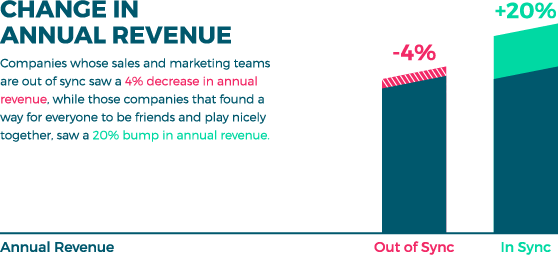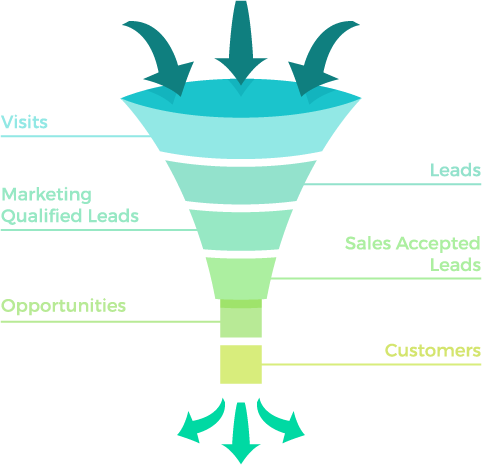
While the legendary marketing and sales rivalry may be older than the cold call, aligning their activities is critical to improving business performance, and profit. When sales and marketing work together, they can impact ROI, productivity, and growth. Here's how to align your teams.
When it comes to sales and marketing, I’ve spent the majority of my career on the marketing side, either working at an agency providing support to businesses, or as a freelance consultant in branding, communications, advertising, and strategy.
It was always a bit of a Debbie Downer moment when our team would present a strategy or campaign or something we thought was super smart to the client (usually the marketing team) and they would agree, “That’s super smart!”, but then later in the meeting someone would inevitably say, “But I don’t know if the sales team is going to like it.”
Or worse, the client would leave the meeting and us with the feeling we had hit the nail on the proverbial head but three days later we’d hear, “We’re having trouble convincing sales that this is the direction to go in,” or “Sales doesn’t get how this is going to help them reach their numbers.”
Occasionally someone from sales would attend a meeting where we’d be talking about a brand strategy or something else “market-y” and the body language from that person was rarely encouraging. “That’s nice, but how is it going to help me convince my customers to place larger orders?”
They were always the toughest, most skeptical nuts to crack in the room. I often felt they were missing the point, fixated on numbers, and unable to see the bigger picture.
So over the years, I started to think of sales teams as party poopers and apparently I wasn’t alone.
According to Harvard Business Review, when sales and marketing executives were asked about the terms they use to describe each other, 87% of the responses were negative. Terms that sales used to describe marketing included, “paper pushers,” “academic,” and “irrelevant.”
Marketing described sales as, “simple minded,” “cowboys,” and “incompetent.” And we might as well add “party pooper” to that list.
It was a rift I couldn’t quite wrap my head around. How could two parts of a company that were routinely mentioned in the same sentence be so at odds with each other? How could they ever agree on what the goal was and how to accomplish it?
While the legendary marketing and sales rivalry may be older than the cold call, the real shocker is that it still exists to this day, to the detriment of business growth.
Not surprisingly the relationship between sales and marketing has a huge impact on a company’s revenue. According to the Aberdeen Group, companies whose sales and marketing teams are out of sync saw a 4% decrease in annual revenue, while those companies that found a way for everyone to be friends and play nicely together, saw a 20% bump in annual revenue.

So, needless to say, learning how to work a little United Nations diplomacy between your sales and marketing teams could significantly improve ROI, sales performance, and, most importantly, growth. And maybe even world peace, at least around the office.
Why Can’t We Be Friends?
Before we get into ideas for how to strengthen the relationship between the sales and marketing teams, let’s look at why there’s a problem in the first place.
Take my cousins as an example. Because they’re twins, everyone lumped them together as if they thought and acted the same way (they’re not even identical twins). They resented the fact that people didn’t recognize them as two individual boys with their own interests, skills, and ideas about the future.
Sales and marketing teams are like fraternal twins. If management doesn’t recognize them as distinct teams with different needs, it frustrates people within those departments and ultimately doesn’t produce the desired results.
Goals
The first area of difference is goals.
Sales teams are pushed to meet monthly, quarterly, and annual revenue goals - they’re watching the numbers.
Contrast that to marketing, which traditionally hasn’t been tied to revenue performance in the same way, and people on those teams are thinking more holistically, strategically.
Expectations of Roles
Sales and marketing teams often have a different understanding of what the other should be doing, and how they should be doing it for them.
Marketing thinks that the activity they generate produces leads that the sales team can then act on and try to close. But the sales team can’t always see how those activities are responsible for quality leads or revenue so they feel like they’re alone in doing all the work.
It can also seem to the marketing team that sales ignores all the content and support materials they produce for them, but the sales team thinks they’re not getting the right support or the right materials.
Each feels the other has the easier job, is carrying less responsibility for revenue, and hasn’t got a clue what their day-to-day challenges are.
No wonder there’s a problem.
So here are five suggestions on how to better align sales and marketing and get everyone focused on lead generation and revenue growth:

1. Align the Goals to ROI
Sales’ and marketing’s goals should be the same. They should be linked to ROI, period. They may each have different ways to create that return on investment and reach that goal, but it’s the only finishing line that counts.
This has been more challenging for marketing. Marketers have often had difficulty measuring their effectiveness in contributing directly to revenue, something agencies in particular have fallen short on in terms of client expectations.
By aligning everyone’s goal to ROI and finding ways to track that, like through KPIs (key performance indicators), everyone is going to feel more evenly paced and it should do away with any resentment around feeling like one department is carrying the entire load.
2. Attend Each Other’s Meetings
This was one of the strange things I found working at agencies when we’d get push back from the sales teams. Half the time we didn’t even know, or, admittedly, consider, that we were responsible for creating programs for sales, or think about how what we were doing could be translated into sales activity.
We rarely got to speak to sales directly, and our clients rarely brought them along to meetings (again, we were usually we dealing with the client’s internal marketing department).
So anything we were finding out about sales’ needs and challenges was after the fact, like sales just not implementing our strategy.
We tried to push back on this and started to insist that someone from sales be involved in the upfront discovery session so we could find out as much as we could in the beginning what sales needed to perform and what they were hearing at a customer level.
Then we could take those findings into consideration when developing our strategy or campaign, and provide guidance on how sales could apply it to their own benefit.
Working in silos is one of the most inefficient and damaging practices of any business. You need to understand how each department works, how what they do affects the company, and how it affects what you do.
Sales and marketing need to share information, not give or take orders from each other. By communicating better, each side can gain valuable intelligence that can help them be more effective in contributing to that ROI goal.
3. Focus on Your Sales Funnel
Sales and marketing usually have different ideas of what the stages of the sales funnel are, and what activities need to be completed to move a lead to the next level.
By defining the funnel together and agreeing on what happens at each stage, everyone knows what their role is and has more confidence about the kind of leads being produced and their ability to convert them.
While every business funnel may be slightly different, here’s a general example of the process:

4. Agree on Lead Generation
If marketing’s job is to generate leads that are handed off to sales to move further down the sales funnel toward a closed deal, there better be agreement on your definition of a Marketing Qualified Lead (MQL), Sales Accepted Lead (SAL), and a Sales Qualified Lead (SQL).
What often happens is the marketing team defines the MQL, which is generally a combination of characteristics (what industry they’re in, what level of decision maker they are), and behaviour (they’ve asked for a demo, they’ve engaged with your content) that add up to someone they think could be a potential customer.
The sales team outlines both what a SAL is — a lead that sales agrees has potential and will follow up with, and a SQL — a lead the sales team feels confident is going to convert into a customer.
If you’re not both in agreement about what makes a good lead, then there’s going to be disagreements about how marketing isn’t sending the right kind of leads that sales can actually close. Meanwhile marketing will accuse sales of squandering all the leads they send them by not closing enough deals.
So by defining and agreeing on the who, the what, and the when for the perfect timing to hand off to sales, the chances of successful follow through will increase significantly.
5. Collaborate on Great Content
Content’s role is to lure in potential leads and move them further down the funnel so it can be determined whether they’re a MQL or not.
It’s marketing’s job to create the content to support sales in this quest.That could be anything from blog posts and lead magnets, to product information sheets and proposals.
However, often times marketing decides what the content will be without much consultation with sales. Then they get upset when sales doesn’t use their materials or complains they’re not being supported properly.
To create great sticky content, marketing really needs to understand the customer and what their needs are, their objections, their questions. This shouldn’t be done based on assumptions, and there’s a valuable resource at the ready: the sales team. Since salespeople are the ones on the frontline, this is information they can provide to marketing to help inform the content.
Marketing and sales must to work together to define what the content needs are in every stage of the funnel, and ensure its customer-focused. This will make the entire process more efficient and effective.
We’re all on the same side
It is critical that sales and marketing teams lay down their egos, open the doors of communication, and remember that they’re all playing for the same team: the business.
By following these steps and changing thinking from one of adversarial competition to that of mutually beneficial collaboration, they’ll find it easier to do their jobs, their success rate will increase, and the business will prosper.

Director of Communications @proposify. Channeling Maria Von Trapp, Queen Elizabeth II, and my taxi-driving, yard-sale-obsessed grandmother. Professional word nerd and unapologetic disciple of the Oxford comma. Connect on LinkedIn


